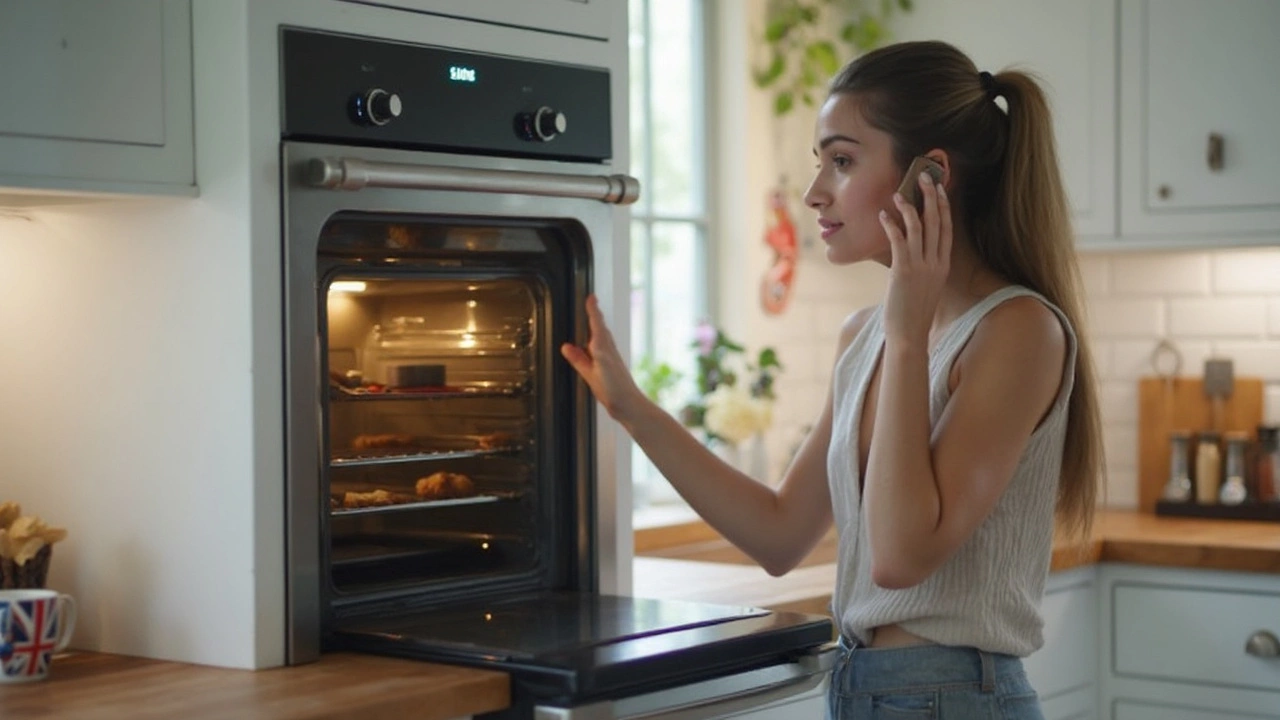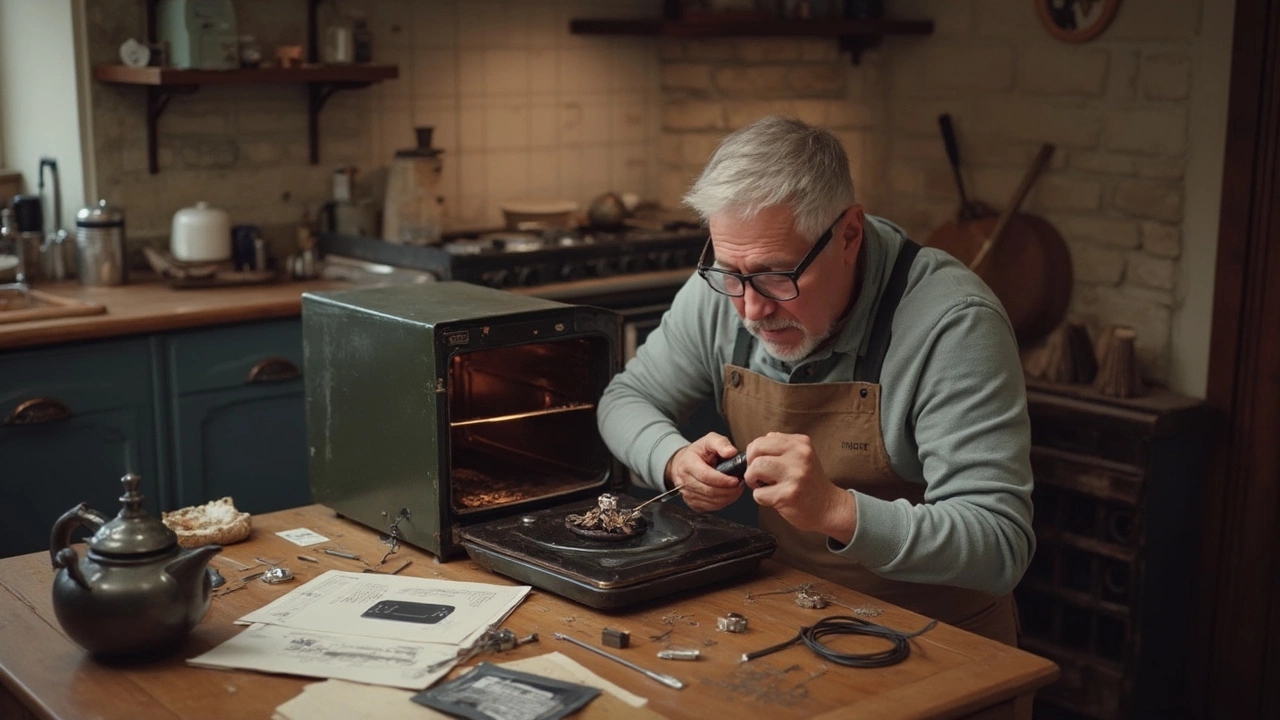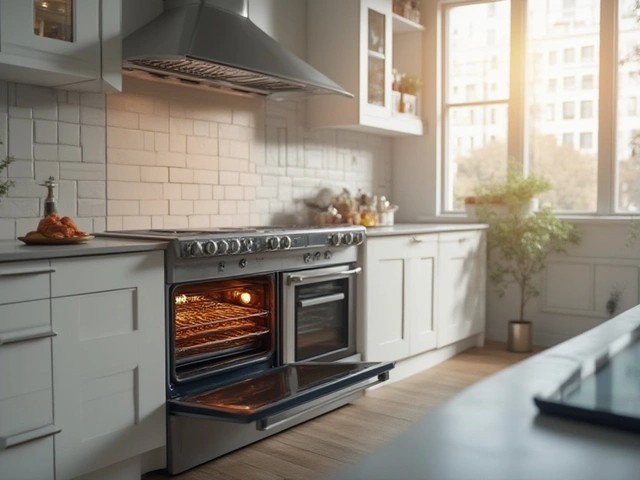Ever tried baking a pizza only for it to come out half-cooked? Pretty frustrating, isn't it? Well, before you pick up the phone to call for repairs, let's first see if you can diagnose your oven's mood swings yourself.
First off, check the basics. Is your oven plugged in and switched on? You'd be surprised how many issues are just down to a loose connection or a flipped breaker. Now, assuming it's got juice, a common issue could be with the heating elements. Is one element not glowing red or is it just lukewarm? This could signal a faulty heating element, which often needs replacing.
Sometimes your oven might misbehave because of a bad temperature sensor. If your oven's been baking things either too fast or not enough, it's worth testing this part. You can do this with an ohmmeter; if the resistance isn't right, it might be time to replace it.
- Spotting Common Oven Problems
- Understanding Electrical Components
- DIY Troubleshooting and Fixes
- Safety and When to Call a Professional
- Prevention Tips and Oven Maintenance
Spotting Common Oven Problems
Think your oven is busted? Hold up; maybe it's just throwing a hissy fit. Before shelling out for a repairman, let's talk about symptoms to look out for.
Uneven Heat Distribution
Does one side of your pizza burn while the other stays raw? This could be a sign of uneven heat. This could be down to either a dodgy heating element or faulty convection fans.
Self-Cleaning Feature Not Working
Self-cleaning ovens are lifesavers, but not when they refuse to kick in. Usually, the culprit is a broken door lock. This feature won't activate if the door can't lock securely.
Strange Noises
Ovens aren't exactly whisper-quiet machines, but if you hear clicking or buzzing, particularly when using certain functions, it might be time to pay attention. The problem could be anything from a fan obstruction to damaged electronics.
"Properly diagnosing the issue can save you both time and money," advises George Cook, a certified appliance therapist with over 20 years of experience. "Sometimes what seems like a major malfunction is just a minor glitch."
Food Not Cooking Evenly
If your meals come out raw in the middle yet crispy on the outside, it could be more than the recipe. An out-of-whack temperature sensor is a likely suspect.
Oven Won’t Turn On
The most heart-stopping issue is when your oven refuses to turn on at all. Triple-check the basics—plug, circuit breaker, and whether the kitchen gremlins have messed with the settings.
- If it's none of these, the culprit could be a blown thermal fuse.
- A defective control board is another possibility.
Any of these issues ring a bell? Sometimes knowing what you're up against is half the battle. Keep these in mind the next time your electric oven acts more capricious than consistent.
Understanding Electrical Components
Figuring out what's going on inside your electric oven can seem like you're tackling a mystery novel, but let's break it down a bit. Knowing these components can be a game-changer when diagnosing electric oven issues.
Heating Elements
These are the heart of your oven. Typically, you'll find the baking element at the bottom and the broil element at the top. If one of these isn’t warming up, it could be burned out. Replacing a heating element is a common fix, but ensure you're getting the right one for your model.
Thermostat
This part controls the temperature. If your oven is heating up erratically or not at all, the thermostat might be off. It measures the air temp, and any kinks here mean your dinner's in for a surprise. Check it with a multimeter to see if it needs a swap.
Temperature Sensor
Sometimes mistaken for the thermostat, the sensor is responsible for monitoring the oven's internal temperature and telling the fan or heating elements to do their thing. If baking's turning into a burnt offering or coming out gooey, it's worth checking this sensor.
Control Board
If the oven's acting possessed—turning on or off unpredictably—this might be your culprit. This electronic hub manages the whole operation. It might need to be reset or replaced if it's gone rogue.
Wiring and Connections
The wiring is like your oven's nervous system. If wires corrode or connections become loose, you could face intermittent issues. These fixes usually need a pro, but checking for obvious signs of wear can save some time.
These electrical bits make your oven a modern marvel, so if they hiccup, understanding their function can help you decide if it’s Solvable by you or needs a tech's gentle touch.

DIY Troubleshooting and Fixes
Tackling oven issues yourself might sound a bit intimidating, but trust me, it's not rocket science. Let's walk through some fixes you can try before calling a pro.
Check the Heating Elements
If your electric oven isn't heating up properly, start by checking the heating elements. A common sign of a faulty element is if it's not glowing red when you turn up the heat. Replace it if necessary. Remember to unplug your oven before getting started to avoid any nasty shocks.
The Temperature Sensor
Your oven's temp can go wonky if the sensor is off. Test it using an ohmmeter: it should show resistance between 1000-1100 ohms at room temperature. Anything else means you'll probably need a new sensor.
"Many electric oven repair issues are solvable at home if you've got the patience," says Gary Lynch, a well-regarded appliance technician from TechFix Solutions.
Consult the Control Panel
When everything else checks out but the oven's still acting up, the control board be the sneaky culprit. Examine for any obvious signs of damage like burnt marks or poor wiring. If it seems suspicious, replacement is usually more practical than repair.
Odd Noises and Strange Smells
Some noises and smells are normal, especially if it's a new oven. But strange ones should be given attention. Inspect the fan motor and look out for any blockage or wear. Regularly clean any spills or food fragments inside the oven to prevent smells and smoke.
Basic Safety Measures
- Always unplug your oven before tinkering.
- Use gloves and safety goggles for protection.
- Reference your oven’s manual for specific troubleshooting advice.
While you might feel like a repair guru tackling these fixes, remember some problems need a professional hand. If you're ever in doubt, it's safer to call an expert.
Safety and When to Call a Professional
We all like to tinker with things around the house, but when it comes to electric ovens, safety is huge. Electric ovens, like most appliances, run on live electrical currents, making safety non-negotiable. Before you start poking around, unplug the oven to avoid any nasty surprises. No one wants to be on the business end of a live wire!
When It's Time to Get Help
While fixing an oven problem can be satisfying, some repairs are best left to the pros. Here’s a rule of thumb: if it involves wires or the internal parts that you’re unfamiliar with, it's time to call someone. Major issues like a completely faulty oven, electrical shorts, or strange burning smells should raise the alarm.
One reason to call a professional is the risk of electric shock. Even if something seems simple, like replacing an internal fuse, not doing it correctly can lead to injury. Also, depending on local regulations in the UK, tampering with modern appliances might void warranties or not meet safety standards.
Electrical Components and Repairs
Dealing with certain components like the thermostat or internal wiring requires specialized knowledge. Professionals have the tools and skills to diagnose intricate issues accurately, saving you the headache of trial and error.
If you’re seeing fluctuations in voltage levels affecting your oven, this could be a sign of bigger electrical issues within the home. A professional can assess and rectify these issues effectively.
How to Choose the Right Service
So, you've decided to bring in the cavalry. It’s essential to choose the right repair service. Look for technicians certified by recognized bodies like NICEIC or ELECSA in the UK. Getting quotes from a couple of places and reading reviews can ensure you're in safe hands.
Remember, a call-out fee might seem steep, but the peace of mind knowing your oven’s repair is in expert hands is worth it. Plus, professional repairs can extend the life of your oven, saving cash in the long run!

Prevention Tips and Oven Maintenance
Keeping your oven in top shape doesn't just happen; it requires a bit of attention and elbow grease. Trust me, tackling a few simple maintenance tasks can save you from unnecessary repairs and extend the life of your trusty oven.
Regular Cleaning
One of the easiest ways to prevent oven problems is also the most obvious: regular cleaning. It's tempting to ignore spills and drips but leaving them to bake on can cause more issues down the line. Make it a habit to wipe down your electric oven after each use. For stubborn grime, use a mixture of baking soda and water. It's safe and doesn't give off harsh fumes like some store-bought cleaners.
Check the Seals and Hinges
Over time, the door seals can wear out, leading to heat escaping and your oven working overtime. Regularly inspecting the seals for damage or wear can stop this problem before it starts. Similarly, ensure that the door hinges allow the door to close properly. A door that doesn't seal tight can mess up your cooking time and waste energy.
Keep an Eye on the Heating Elements
If you notice your oven is not heating evenly, it could be an issue with the heating elements. Give them a quick look every so often, especially if your baking isn't turning out as expected. Catching a faulty element early can make all the difference.
Mind the Electrical Connections
If you're handy with tools, check the electrical connections yearly. Loose or frayed wiring can lead to bigger issues if not addressed. Remember, always make sure the power is off when you’re poking around in there.
Create a Maintenance Schedule
Set reminders for yourself to conduct a few key maintenance checks. Every six months, deep clean the oven and inspect all the components. This schedule keeps your oven running smoothly and might just prevent a total breakdown. So, jot it down in your calendar or set a phone alert; future you will thank you.
| Maintenance Task | Frequency |
|---|---|
| Clean Spills & Grime | After Each Use |
| Inspect Door Seals & Hinges | Monthly |
| Check Heating Elements | Quarterly |
| Inspect Electrical Connections | Yearly |
With these simple prevention tips, you'll keep your oven in good shape and cooking up a storm. Who doesn't want to save time and avoid unexpected costly repairs? Your oven will thank you for the TLC.




